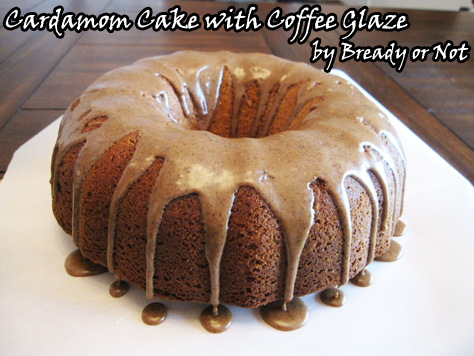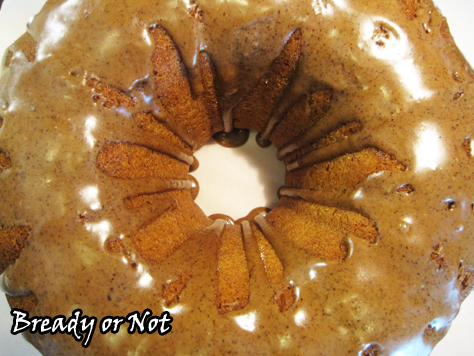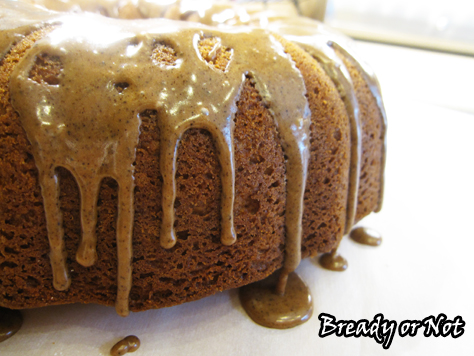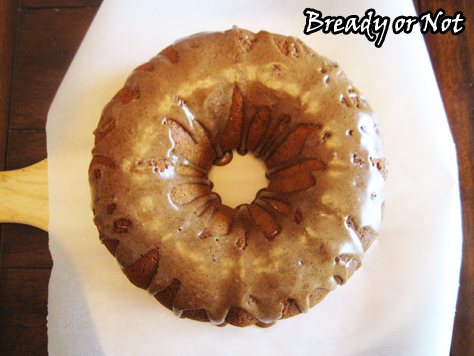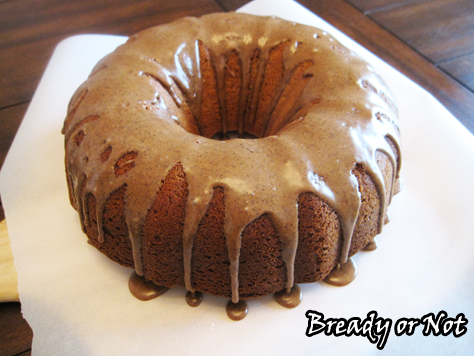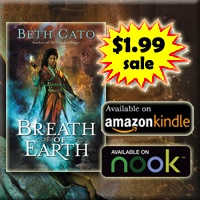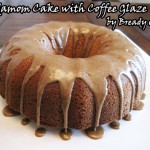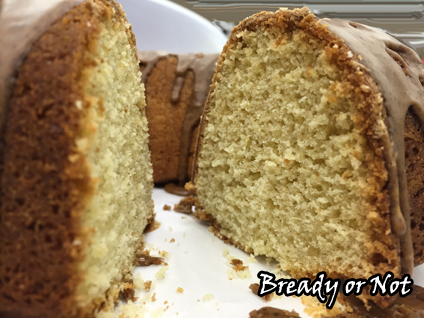Sunday Quote has a giveaway ending soon
“Some books should be tasted, some devoured, but only a few should be chewed and digested thoroughly.”
~ Francis Bacon
Goodreads Book Giveaway
Read More
Bready or Not: Cardamom Bundt Cake with Coffee Glaze
It’s June and hey, let’s eat cake! Cardamom Cake with Coffee Glaze. A bundt cake full of sugar and glory and cardamom-y goodness.
I read a lot of books. I also read a lot of magazines. One of my favorite things to do is hit up a good used book store or library book sale and buy stacks of older food magazines to raid for recipes.
That’s how I found the original recipe for this in an October 2013 issue of Country Living. I modified it, removing pistachios and tweaking here and there, and created a cake that earned the utter adoration of my husband’s co-workers.
Coffee and cardamom is a fantastic flavor combination. You might remember the Cardamom Coffee Pound cake I posted last fall. This bundt cake is like that awesome loaf cake, and so much more.
It’s bigger, for one, being a full-size cake. It has a kinda pound cake thing going, too. The sour cream does miraculous thing for cake texture, creating crumb that is dense, not crumbly.
This is a cake you can eat out of hand, no saucer required. And you’ll want to lick your fingers clean, too, because the glaze includes espresso powder (one of my favorite ingredients to keep around) and sugar.
If the caffeine doesn’t boost your day, you know the sugar will!
Bready or Not: Cardamom Bundt Cake with Coffee Glaze
Ingredients
Bundt cake
- 1 cup unsalted butter 2 sticks, room temperature, plus more to grease pan
- dried breadcrumbs fine texture, to dust pan
- cooking spray
- 2 1/3 cups cake flour
- 1 1/2 teaspoons ground cardamom
- 1 1/2 teaspoons baking powder
- 3/4 teaspoon baking soda
- 1/2 teaspoons salt
- 1 1/2 cups white sugar
- 4 large eggs room temperature
- 1 teaspoon vanilla extract
- 1 cup sour cream 8 ounces
Coffee glaze
- 2/3 cup confectioners' sugar sifted
- 1 teaspoon espresso powder
- 1/4 teaspoon unsweetened cocoa powder
- 1 Tablespoon milk or half & half, plus more if needed
Instructions
- Preheat oven to 350-degrees. Generously butter a 10 or 12-cup Bundt pan. Dust the pan with fine bread crumbs; a toasted and pulverized half heel of bread will do. Apply cooking spray over the bread crumbs.
- In a medium bowl, whisk together flour, cardamom, baking powder, baking soda, and salt; set aside.
- In a large bowl, use a mixer on medium to beat the butter and sugar until light and fluffy. Add eggs one at a time followed by the vanilla extract, beating until very pale yellow.
- Reduce the mixer speed and alternate between adding the flour mix and the sour cream into the butter blend.
- Pour the batter into the prepared pan, using a rubber spatula. Bake cake until a wooden toothpick inserted into the cake comes out dry with only a few moist crumbs attached, 45 to 50 minutes. Transfer pan to a wire rack to cool for 30 minutes, then invert cake onto rack to completely cool. Once cool, move cake to cake plate and prepare glaze.
- Whisk together sugar, espresso powder, and cocoa powder. Add milk and stir, adding more milk as needed until glaze is just thin enough to drizzle. Dribble over cake.
- OM NOM NOM!
Read More
Breath of Earth $1.99 continues PLUS new Call of Fire giveaway
The sale on Breath of Earth continues into June! Get the ebook for $1.99 at all major online bookstores:
The deal was featured on Bookbub on the 1st, and I was stunned to see my book make it to #247 out of all Kindle books and #53 out of all Nook books. Wowsers!
Also, I’m giving away two copies of the sequel on Goodreads. Enter below!
Goodreads Book Giveaway
#SFWAPro
Read More
Sunday Quote braces for June
Read More“People without hope not only don’t write novels, but what is more to the point, they don’t read them.”
~ Flannery O’Connor
“Etymology Is Important,” She Ejaculated
I’m going to start off by telling a story from when I was 13 or 14 years old. I was with my mom and grandma in the car as we drove through the Central California countryside after a Sunday visit to my uncle’s church. As is often the case, then and now, I was reading a new book.
“Mom,” I asked, “What does ‘ejaculate’ mean?”
My Mom and Grandma shared a look in the front seat. “Beth, what are you reading?” There was a strange strain to her voice.
“This book called The Little White Horse by Elizabeth Goudge.” I held up the cover so she could see it in the mirror.
Mom and Grandma glanced at each other again. “Read the line to me,” Mom asked.
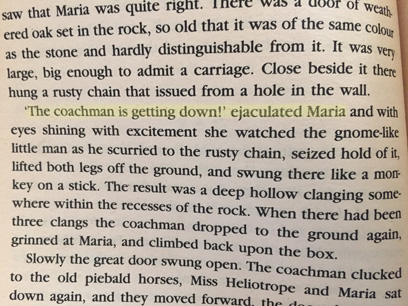 “‘The coachman is getting down,’ ejaculated Maria.'”
“‘The coachman is getting down,’ ejaculated Maria.'”
Mom and Grandma both belted out nervous laughs. “Oh. Is it an old book?” she asked. I confirmed that it was a reprint of an old book, and I was informed I’d be told about other definitions for the word once we arrived home.
Yeah, that was a fun conversation. I was both mortified and amused. I had given them quite a fright with my choice of reading material on the way home from church! (I do recommend The Little White Horse–it’s a lovely gothic middle grade book, and apparently has gained new attention in recent years as it’s one of J.K. Rowling’s childhood favorites.)
Etymology is the history of a word, the how, when, and where of its use. I write historical fiction novels, and I find myself very aware of the words I choose. I cannot be 100% accurate to period, nor do I want to be. I will not have my characters ejaculate their speech, no matter how appropriate that word usage may have been in their time!
It’s all about balance. I want my books to be as easy to read as other current books–with contemporary concepts of paragraph size, dialogue tags, etcetera–while still keeping readers in a distant world.
I frequently check word etymologies as I write and revise. My usual go-to is the Online Etymology Dictionary; if that site doesn’t list the word, I usually resort to a Google search of “etymology [word].
There is also the dilemma of a word seeming contemporary, even though it’s not. This is referred to as “The Tiffany Problem”, named so because Tiffany is a legitimate medieval name but it looks too modern to readers of historical fiction and fantasy. For matters like that, it’s great to get feedback from other readers during early revision stages.
Sometimes, I consciously stay with an anachronistic word. For example, the word “kid” for “child” is a very recent development in the English language.
I also use the word “Reiki” to describe a form of magical healing, though Reiki as a modern practice didn’t start in Japan until the 1920s. On an additional note, my copyeditor for Breath of Earth suggested capitalizing Reiki–that’s what it said in their style guide–so I went with that in the final book. It gives it more gravitas in my 1906 setting.
Word choice does determine the tone. Within a sentence, a writer can establish the setting, time, and point of view. Be choosy. Be cautious. And be aware of what “ejaculate” means in various contexts.
Reposted from Novelocity.
Read More





